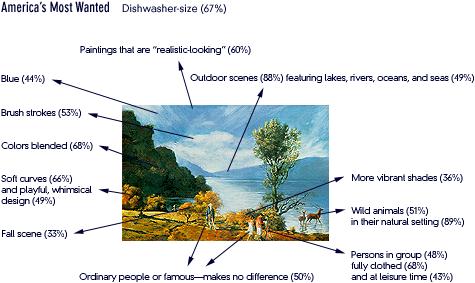KOMAR AND MELAMID'S GUIDE TO THE WORLD'S MOST WANTED ART

BEGINNING ON DECEMBER 10, 1993, trained professionals working from a central, monitored location in Indiana telephoned Americans to find out what they want in art--fine art, specifically painting. For eleven days the survey continued, as people throughout the forty-eight contiguous states pondered: Soft curves or sharp angles? Brush strokes or smooth surfaces? "Realistic-looking" or "different-looking"? Serious or festive? Outdoor scenes or indoor? Wild animals or domestic? Famous people or ordinary? At work or at leisure? On and on, for an average of twenty-four minutes, until all 102 questions had been asked. When it was over, 1,001 adult Americans had been interviewed. They were a statistically representative group, having been selected from all households by a random-probability sampling procedure that included unlisted numbers and was stratified according to state. Their collective responses, the poll results, are statistically accurate within a margin of error of +/- 3.2 percent, at a 95 percent confidence level.The first-ever comprehensive, scientific poll of American tastes in art was commissioned by the Russian emigre artists Vitaly Komar and Alexander Melamid in conjunction with The Nation Institute, a nonprofit offshoot of The Nation magazine. After studying the data, Komar and Melamid commenced to produce two paintings, America's Most Wanted and America's Most Unwanted. After completing those, Komar and Melamid, aided by international polling firms using variations on the American questionnaire, penetrated Europe, Asia, and Africa with their "People's Choice" project. Additional sample populations continue to be identified, so the polling goes on.
To date, the artists have surveyed the opinions of close to two billion people--almost one-third of the world's population--and have translated the numbers into paint on canvas.

- Komar and Melamid discuss blue landscapes, shiny cars, and the kreative krisis of our postmodern age
- To view paintings, use pop-up menu above
Excerpted from PAINTING BY NUMBERS: KOMAR AND MELAMID'S SCIENTIFIC GUIDE TO ART edited by JoAnn Wypijewski. Published by Farrar, Straus & Giroux, Inc. Copyright © 1997 by Vitaly Komar and Alexander Melamid. Copyright © 1997 by JoAnn Wypijewski. All rights reserved.